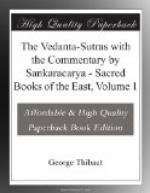is that doubt—; this is the third of my
boons.’—If we therefore supposed
that the passage, ’That which thou seest as neither
this nor that,’ &c., raises a new question, we
should thereby assume a question in excess of the
number of boons granted, and thus destroy the connexion
of the entire Upanishad.—But—the
Sa@nkhya will perhaps interpose—it must
needs be admitted that the passage last quoted does
raise a new question, because the subject enquired
about is a new one. For the former question refers
to the individual soul, as we conclude from the doubt
expressed in the words, ’There is that doubt
when a man is dead—some saying, he is;
others, he is not.’ Now this individual
soul, as having definite attributes, &c., cannot constitute
the object of a question expressed in such terms as,
’This which thou seest as neither this nor that,’
&c.; the highest Self, on the other hand, may be enquired
about in such terms, since it is above all attributes.
The appearance of the two questions is, moreover,
seen to differ; for the former question refers to
existence and non-existence, while the latter is concerned
with an entity raised above all definite attributes,
&c. Hence we conclude that the latter question,
in which the former one cannot be recognised, is a
separate question, and does not merely resume the
subject of the former one.—All this argumentation
is not valid, we reply, since we maintain the unity
of the highest Self and the individual Self.
If the individual Self were different from the highest
Self, we should have to declare that the two questions
are separate independent questions, but the two are
not really different, as we know from other scriptural
passages, such as ‘Thou art that.’
And in the Upanishad under discussion also the answer
to the question, ’That which thou seest as neither
this nor that,’ viz. the passage, ’The
knowing Self is not born, it dies not’—which
answer is given in the form of a denial of the birth
and death of the Self-clearly shows that the embodied
Self and the highest Self are non-different. For
there is room for a denial of something only when
that something is possible, and the possibility of
birth and death exists in the embodied Self only, since
it is connected with the body, but not in the highest
Self.—There is, moreover, another passage
conveying the same meaning, viz. II, 4, 4,
’The wise when he knows that that by which he
perceives all objects in sleep or in waking, is the
great omnipresent Self, grieves no more.’
This passage makes the cessation of all grief dependent
on the knowledge of the individual Self, in so far
as it possesses the qualities of greatness and omnipresence,
and thereby declares that the individual Self is not
different from the highest Self. For that the
cessation of all sorrow is consequent on the knowledge
of the highest Self, is a recognised Vedanta tenet.—There
is another passage also warning men not to look on
the individual Self and the highest Self as different




